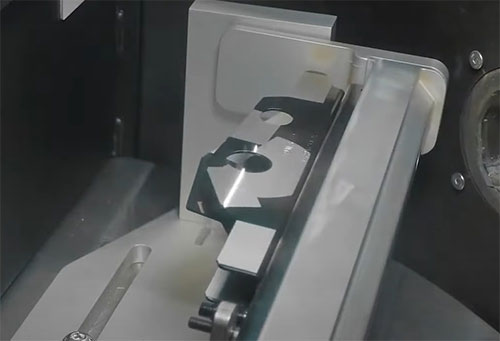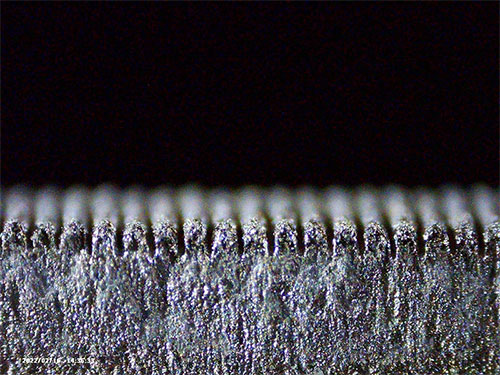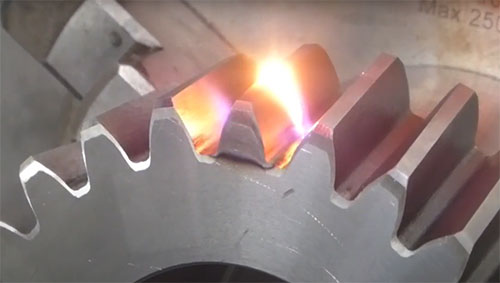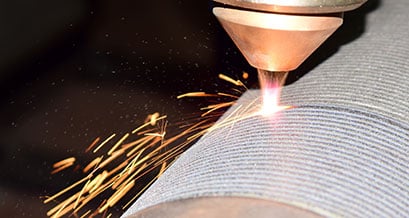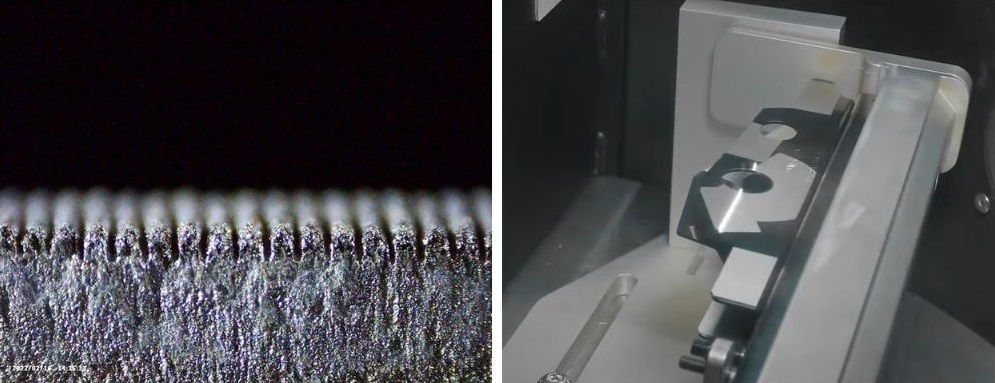
In the automotive and metalworking industries, traditional surface treatments like chemical etching, mechanical abrasives, and PVD are used to modify the surface properties of metals.
Nowadays, laser technology offers better ways to treat metals and meet engineering requirements with increased precision and consistency.
Laser surface treatments can be used on almost all types of metals, including carbon steel, cast iron, aluminum, molybdenum, and magnesium. They can remove contaminants and coatings (laser cleaning), modify the surface roughness (laser texturing), harden surfaces (laser hardening), and add materials to surfaces to improve surface properties (laser cladding).
Table of Contents
- 4 Types of Surface Treatments
- 9 Examples of Metal Surface Treatments
- 1. Laser Texturing Ni-Plated Steel Batteries
- 2. Laser Texturing Aluminum Turbos
- 3. Laser Cleaning Aluminum Housings
- 4. Laser Stripping Powder Coating from Copper Hairpins
- 5. Laser Stripping E-Coating from Steel Seat Brackets
- 6. Laser Oxide Removal from Copper Slip Rings
- 7. Laser Cleaning Electrolyte from Ni-Plated Steel
- 8. Laser Hardening Steel Spacer
- 9. Laser Cladding Steel Guide Rings
4 Types of Surface Treatments
Laser Cleaning of Metals
|
Laser cleaning is a surface treatment that can remove coatings as well as a wide range of contaminants from metals.
|
Selective laser cleaning of e-coating. |
Laser Texturing of Metals
|
Laser texturing, also known as laser structuring, is a complete surface treatment for metal parts. It cleans, textures, and modifies the chemical composition of the surface in a single operation.
|
A linear pattern etched into the surface of a metal part. |
Laser texturing can be used to prepare metals for any type of coat, seal, or adhesive. For example, some of our customers use it to prepare metals for thermal spray coating and adhesive bonding.
Laser Hardening of Metals
|
Laser hardening, also known as laser heat treatment, is a surface treatment used to improve the mechanical properties of metal components, such as hardness, wear resistance, and fatigue strength. The laser beam is directed on the surface of the workpiece, which rapidly heats up the surface layer of the metal. This causes it to quickly melt and cool down. This rapid heating and cooling alters the microstructure of the metal, resulting in a hardened surface layer with improved mechanical properties.
|
A steel gear being hardened in localized areas to improve resistance to wear (source) |
Laser Cladding of Metals
|
Laser cladding is like the 3D printing of metal with a laser. It is a material deposition process used to add thick or thin layers of material on a surface to improve its properties or repair damaged areas. A laser beam is used to melt a powder or a wire, depositing layers that can improve corrosion resistance, wear resistance, and more.
|
|
9 Examples of Metal Surface Treatments with Lasers
1. Laser Texturing Ni-Plated Steel Batteries
Adhesives are increasingly used in EV battery packs to reduce weight, improve the load-bearing strength, and optimize thermal management. Laser texturing is used on battery cells and housings to improve the strength of adhesive bonds.
2. Laser Texturing Aluminum Turbos
Thermal spray coating is used on turbine housings to improve properties like heat resistance, wear resistance, and corrosion protection. Laser texturing before thermal spray coating creates the ideal microstructure on the surface of the housing to ensure strong bonding properties.
3. Laser Cleaning Aluminum Housings
Sealants are used to achieve the high IP rating needed in e-motors. Before the sealant is applied, laser cleaning removes oxides and contaminants to ensure a high-quality bond between the sealant and the aluminum surface.
4. Laser Stripping Powder Coating from Copper Hairpins
In e-motors, hairpin windings are covered with an epoxy resin to insulate them within the stator. Laser cleaning is used to expose the bare copper before welding to ensure that the epoxy does not penetrate the welds.
5. Laser Stripping E-Coating from Steel Seat Brackets
Laser cleaning is used to remove the e-coat from areas used for assembly on seat brackets. It exposes the bare steel to ensure that the e-coat does not diminish adhesion during assembly. The process shown in the video perfectly demonstrates the selective capabilities of laser cleaning.
6. Laser Oxide Removal from Copper Slip Rings
Laser cleaning is used to remove copper oxides that form on slip rings. This improves the electrical conductivity between slip rings and brushes to optimize the performance of the electric motor.
7. Laser Cleaning Electrolyte from Ni-Plated Steel
Liquid electrolyte can end up on critical components of cell casings, causing issues like short circuits and corrosion. Laser cleaning is used to remove electrolyte, liquid or dried, as well as other contaminants on the surface of battery cells.
8. Laser Hardening Steel Spacer
Laser hardening can be used to harden selective areas on steel, making it more durable.
9. Laser Cladding Steel Guide Rings
Laser cladding can be used to repair steel surfaces by depositing new material.
Conclusion
Laser cleaning and texturing have the potential to improve the precision, speed, and repeatability of metal surface treatments—all while reducing operating costs significantly. If you are interested in discussing a cleaning or texturing application with a laser expert, contact us today.
